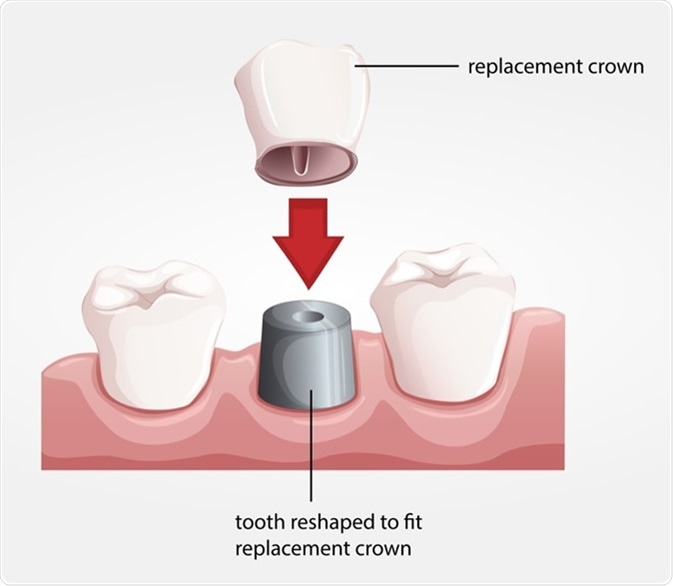At least two dental visits are typically needed to prepare a tooth for a dental crown to be placed. The purpose of the first dental visit is to examine and prepare the tooth that is to be crowned and create an impression of the tooth so that the crown can be constructed. A temporary crown to protect the tooth is also usually placed during this visit.
In the second visit, which occurs once a dental laboratory has constructed the crown, the temporary crown can be removed and the permanent custom-made crown fixed in place.

Illustration of a dental crown procedure. Image Credit: BlueRingMedia / Shutterstock
First Visit: Investigation, Tooth Reshaping, Impression and Temporary Crown
During the first dental visit, an X-ray is usually taken of the tooth and jawbone to investigate for signs of decay and other factors that could increase the risk of infection or injury to the pulp of the tooth. For some patients, root canal treatment may be required prior to the placement of a crown on a tooth.
The tooth will need to be shaped to allow room for the crown to be placed; the extent of reshaping will depend on the type of crown being used. Metal-based crowns tend to be thinner and, therefore, require the removal of less structure of the tooth than porcelain crowns. The top and sides of the tooth are filed down to shape the tooth as needed for the crown. Any tooth decay should also be treated during this step.
What is a perfect Dental Crown
For some patients with severe decay or damage to the tooth, there may be insufficient tooth structure remaining to place the tooth. In this case, a filling material may be needed to build up the structure of the tooth so that the crown can later be put in place.
Once the tooth has been adequately shaped, the next step is to create an impression of the shaped tooth so that the crown can be made to fit the tooth as closely as possible. An impression also often needs to be created for the tooth on the opposing jaw that will connect with the crown when the patient bites. This is to ensure that the crown fits well to the other side of the mouth, in addition to the area where it will sit.
Impressions are usually made using a paste or putty that holds the shape of the tooth. It is spread over the area to be copied and then pulled away, keeping the shape of the relevant teeth on its surface.
At this point, it is important to record details about the tooth that will affect the production of the crown, such as the natural fit and color. Ideally, the color of the crown should match that of the tooth and surrounding teeth so that it is not noticed when it is placed inside the mouth.
Finally, a temporary crown is usually placed over the tooth to protect it until the crown has been constructed and is ready to be fixed in place. This will be removed at the next dental visit to make room for the permanent crown.
Second Visit: Permanent Crown Placement
In the meantime, the impressions of the teeth are sent to a dental technician or laboratory to form the crown in the correct shape. This process typically takes up to three weeks, which is why more than one dental visit is needed to place a permanent crown correctly.
Once the dental technician or laboratory has created the crown, it is time for the crown to be placed over the tooth. If a temporary crown has been placed, this should first be removed.
It is important to check that the crown has been made correctly, ensuring that both the fit and the color of the crown match that of the natural and surrounding teeth before it is cemented in.
A local anesthetic is usually administered to numb the area during the procedure to fit the crown. Dental cement is utilized to fix the crown in place over the tooth. It may be necessary to make small adjustments to the shape of the crown, particularly if there are problems with the patient’s bite when the crown meets the opposite tooth.
Same-Day Crowns Placement Procedure
In some cases, crowns may be constructed in the dental practice so that the crown can be made and placed on the same day, without the need to send the impressions to a dental laboratory.
Rather than making an impression of the tooth, a scanning device called a wand is used to take pictures of the teeth. These images are uploaded into computer software that creates a 3D model of the tooth. This digital model can then be used to create a ceramic crown the same day. This method is known as computer-aided design and manufacture of dental crowns (CAD/CAM) and can be completed in approximately 15 minutes so that the crown can quickly be put in place.
References
Further Reading
Last Updated: Feb 26, 2019